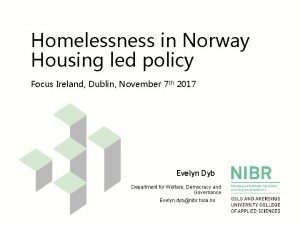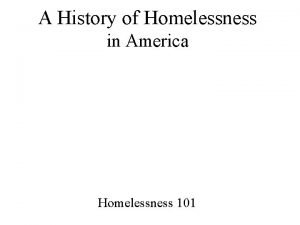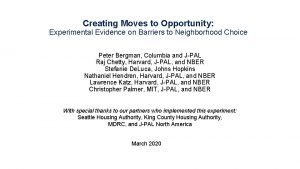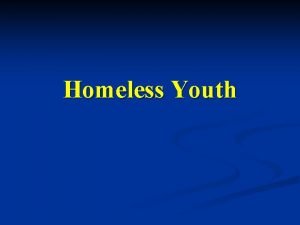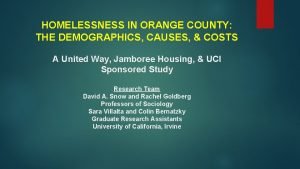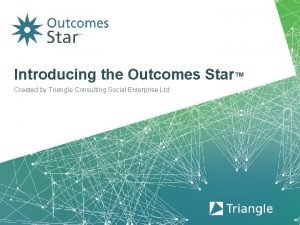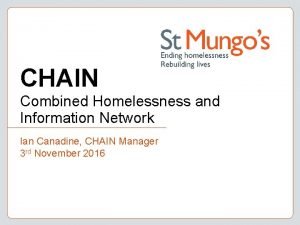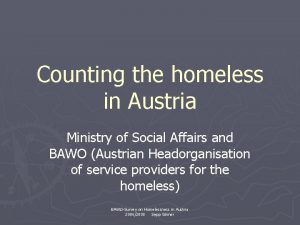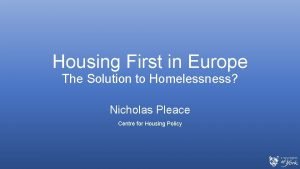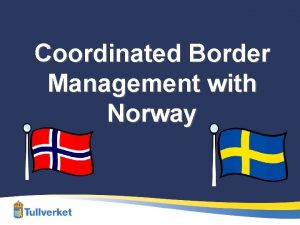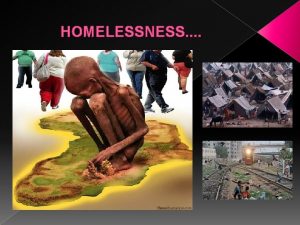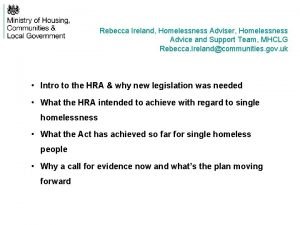Homelessness in Norway Housing led policy Focus Ireland

















- Slides: 17

Homelessness in Norway Housing led policy Focus Ireland, Dublin, November 7 th 2017 Evelyn Dyb Department for Welfare, Democracy and Governance Evelyn. dyb@nibr. hioa. no

Comparing Ireland Norway Population 2016/2017 - Ireland 4. 7 million - Norway 5. 2 million Comparing national homeless strategies - Ireland, England, Northern Ireland, Scotland, Wales, Denmark, Norway, Sweden. Benjaminsen, Dyb & O’Sullivan; European Journal of Homelessness 2009 The ‘Arc of prosperity’ after - Ireland, Scotland, Iceland, Norway (Scottish government 2007) Anderson, Dyb & Finnerty; Perspective 2008 - The ‘Arc of prosperity’ revisited – homelessness the GFC) Anderson, Dyb & Finnerty, Social Inclusion 2016

Defining homelessness A person without a privately owned or rented accommodation and is in one of these situations: • Staying in occasional or temporary lodging • Lives temporary with friends, acquaintances or relatives • Lives in institution and is due to be discharged within two months • Stays in a correctional facility and is due to be released within two months • Sleeps rough/has no place to stay

Measuring homelessness • Cross sectional survey – time window of one week • Respondents: municipal services and agencies (social services), NGOs, other private services, state agencies (national health services and correctional services) • One questionnaire for each homeless person the respondents are in touch with or know of in the time window • Time series with data on individual level Homeless persons in touch with and/or known by a wide range of services


Increase and decrease in homelessness Year Numbers Per 1000 pop. 1996 2003 2005 2008 2012 2016 6, 200 5, 496 6, 091 6, 259 3, 909 1. 5 1. 14 1. 19 1. 27 1. 26 0. 75

Who are the 3, 909 persons? A residual group; «those hard to house» ?

Profile 2016 and 2012 (1) Men Women <25 years Daily care for children Norwegian born Long term homeless New/acute situation 0 10 20 30 40 2016 2012 50 60 70 80 90

Profile 2016 and 2012 (2) Soc. Sec. Benefit Disability pension Other welfare ben. Dependency drug/alc Psychiatric illness Evicted <6 months 0 10 20 2016 2012 30 40 50 60

Family homelessness – parent(s) with minor children Year No. of parents 2008 2012 182 357 No. of children 400 679 2016 131 229 The majority of the parents are women Income sources: welfare benefits (18 % has work related income, vs 7 %) The majority is borne outside Norway Doubling up or live in temporary accommodation Homelessness in a new/acute problem (59 % vs 20 %)

Homelessness population and national programs/strategies 1. 6 1. 5 1. 4 1. 3 1. 2 1. 1 1 0. 9 0. 8 0. 7 0. 6 0. 5 0. 4 First survey 1996 Project Homeless 2000 - National Strategy 2005 - Social Housing Program Housing for Welfare 2014 2007 2009 -2014 -

Surveys interventions Survey 1996 – highlighted a «new» social problem A White Paper in 1998/99 (The Equality Report): launched a policy intervention against homelessness Project Homeless 2001 – 2004 - A trial program - The largest cities/municipalities - Objectives: develop models to prevent and fight homelessness - Based on the staircase of transition

From staircase to housing led • Project Homeless changed from a staircase to a housing led approach • Influence from the Swedish criticism of the staircase model (circulation in the various steps of the staircase, few reached the top) • Institutional embeddedness in the Norwegian State Housing Bank (The Housing Bank) • The staircase model did not represent a new approach – abstinence before housing was “the usual way”

The pathway to a permanent home • National strategy to prevent and combat homelessness – 2005 -2007 • Peer reviewed, recognizing the housing led approach • Expanded to all municipalities • A combination of performance targets and interdepartment and multi-level governance • State funding through the Housing Bank and the Social Directorate (competence, services, local projects) • National coordinator: The Housing Bank

Social Housing Development Program • 2009 – (2014) • Long term partnership between the Housing Bank and (a selection of) municipalities • The municipalities set their own targets based on an external evaluation and a national frame • Active use of the Housing Bank’s financial instruments • State project funding is cut down • Homelessness at the core of the program, also expanded to disadvantaged households

Housing for welfare 2014 -2020 • National strategy for housing and support services • Signed by five Ministers in five welfare policy fields • Multi-level and horizontal co-governance and innovation • Policy areas expanded to neighbourhood development, housing quality and local planning • Particular target groups: families and young persons (refugees with recidence permit) • The Housing Bank’s Social Housing Program is part of the strategy

Summary • The homeless censuses broadened and set the concept and definition of homelessness • Specific groups of homeless and specific problems identified in the census have been addressed and focused in the programs and strategies • The number of homeless persons measured in the censuses is a ‘litmus test’ on the efficiency of the work on national and local levels • Institutional embeddedness in the Housing Bank has kept the focus on housing led interventions
 Homelessness in norway
Homelessness in norway Porter's competitive strategies
Porter's competitive strategies Drivers of differentiation
Drivers of differentiation Actor focus vs object focus
Actor focus vs object focus Focus on form vs focus on forms
Focus on form vs focus on forms Michigan campaign to end homelessness
Michigan campaign to end homelessness Timeline of homelessness in america
Timeline of homelessness in america Homelessness
Homelessness Homelessness prevention team bristol
Homelessness prevention team bristol Abolish homelessness
Abolish homelessness The bill homelessness was
The bill homelessness was Definition of youth homelessness
Definition of youth homelessness Youth homelessness definition
Youth homelessness definition Orange county demographics
Orange county demographics Outcomes star
Outcomes star Chain homelessness
Chain homelessness Homelessness in austria
Homelessness in austria Finland homelessness solution
Finland homelessness solution
